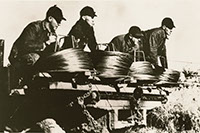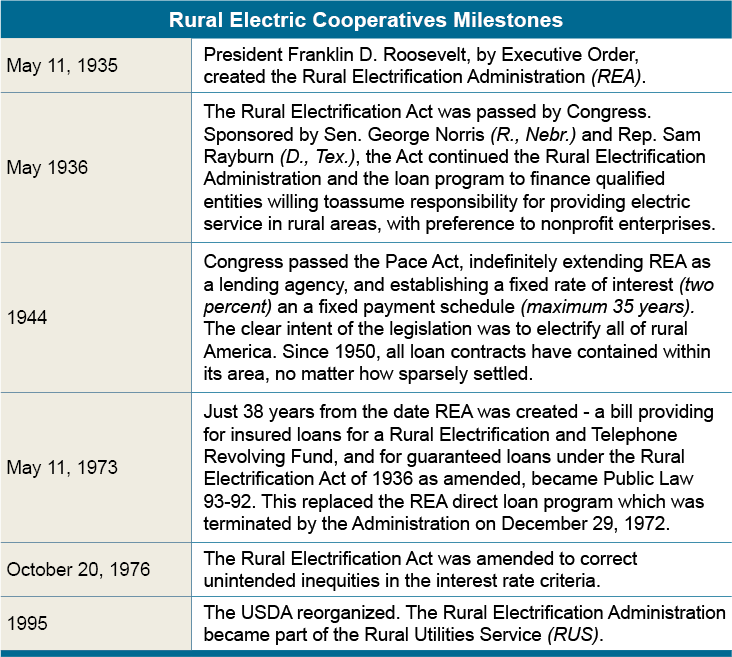


SEARCH MyCVEC
Facts
The History of CVEC:
In 1937 only about 10% of Central Virginia's citizens had been successful in obtaining electric service from the utilities in the area. A group of citizens in the Rockfish Valley area of Nelson County decided to explore the possibilities of forming a cooperative and borrowing funds from the newly formed Rural Electrification Administration to construct their own electric service. The idea spread rapidly, resulting in the formation of a county-wide organization. The application for a charter was executed at a well attended meeting on September 20, 1937, at Lovingston High School. Early founders included L.C. Dawson, S.T. Rodes, G.H. Whitehead, James Sites, F.R. Moon, and Fred Schilling. The State Corporation Commission granted the charter on September 22, 1937.
![]()
How It All Started
A full history of the formation of CVEC can be read here.
![]()
CVEC Timeline

![]()
Co-ops in General
 Member-owned utilities were established to provide electric service in rural America. While most of the rural utilities are public entities, such as public power districts, some are member cooperatives, incorporated under the laws of the states in which they operate. A member cooperative is a not-for-profit enterprise, set up to meet a common need, and owned and controlled by the people it serves.
Member-owned utilities were established to provide electric service in rural America. While most of the rural utilities are public entities, such as public power districts, some are member cooperatives, incorporated under the laws of the states in which they operate. A member cooperative is a not-for-profit enterprise, set up to meet a common need, and owned and controlled by the people it serves.
![]()
Organization of Co-ops
Almost 1,000 electric cooperatives form a countrywide rural electric network serving 35 million people in 46 states. Most cooperatives are distribution systems, but some are power supply systems, known as G&T's - generation and transmission. In most states where rural electric systems are located, statewide associations supply valuable statewide coordination and services. These associations are financed through dues from members, and revenues from services. They vary in size and resources, but they all adhere to principles of cooperatives working with other cooperatives.
 The National Rural Electric Cooperative Association (NRECA), formed in 1942, represents the national interests of members. NRECA provides legislative services and programs in management, insurance, public relations and advertising, research, and energy and environment. NRECA is, like statewide associations, financed by dues and revenues.
The National Rural Electric Cooperative Association (NRECA), formed in 1942, represents the national interests of members. NRECA provides legislative services and programs in management, insurance, public relations and advertising, research, and energy and environment. NRECA is, like statewide associations, financed by dues and revenues.
The Rural Utilities Service (RUS) of the Department of Agriculture does not own or operate any rural electric organization - local, statewide, or national. RUS provides insured and guaranteed loans and technical assistance where needed.
![]()
Statistical Highlights
Rural electric systems serve about 15 million farms, homes, schools, churches, irrigation systems, commercial enterprises, and other establishments in 2,500 of the 3,128 counties or county-type areas of the United States. Co-ops and other not-for-profit electric utilities are present in about 80% of the U.S. Counties but serve the less populated areas.
Although America's rural electric systems serve about 35 million people, they average 6.6 consumers and $8,500 gross annual revenue per mile of line. In comparison, most commercial utilities average 5 times as many customers and 7 times as much revenue per mile of line.
In the 1930's, when the rural electrification program began, about 10 percent of America's farms had central station electric service. Today, that figure is more than 98 percent. The program was established to help provide electric light and power not only to farm people but also to all customers not being adequately served in rural areas.
Rural electric systems own and maintain nearly 43 percent of the electric distribution lines in the United States but own only a little more than 5 percent of the nation's generating capacity.
![]() For more information about rural electric eooperatives visit the NRECA website.
For more information about rural electric eooperatives visit the NRECA website.
![]() For more information about RUS Electric Programs visit the RUS website.
For more information about RUS Electric Programs visit the RUS website.
![]()
Rural Electric Cooperatives Milestones

![]()
Other History Links:
![]() CVEC on PBS: CVEC was featured as part of a public television documentary on rural electrification during the Depression Era. View The Ground Beneath Our Feet here.
CVEC on PBS: CVEC was featured as part of a public television documentary on rural electrification during the Depression Era. View The Ground Beneath Our Feet here.
![]() Power in the Limelight: Electricity in the Limelight, an essay by Thomas Thurston, New Deal Network
Power in the Limelight: Electricity in the Limelight, an essay by Thomas Thurston, New Deal Network
![]() What REA service means to our farm home: The first benefit we received from the REA service was lights, and aren't lights grand? My little boy expressed my sentiments when he said, "Mother, I didn't realize how dark our house was until we got electric lights..."
What REA service means to our farm home: The first benefit we received from the REA service was lights, and aren't lights grand? My little boy expressed my sentiments when he said, "Mother, I didn't realize how dark our house was until we got electric lights..."
HOME | REPORT AN OUTAGE | PAY MY BILL | CONTACT CVEC
Phone: 434.263.8336 | Toll free: 800.367.2832 | Fax: 434.263.8339
Corporate Headquarters:
800 Cooperative Way
Arrington, VA 22922
Payments:
Dept. 1340 | PO Box 2153
Birmingham, AL 35287-1340
Correspondence:
P. O. Box 247
Lovingston, VA 22949
